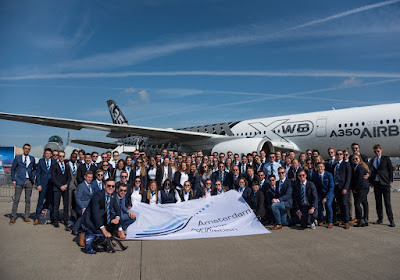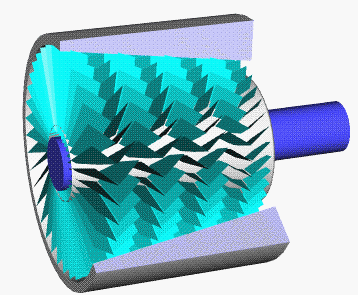On the 27th
of April, I visited the ILA Berlin Airshow with a group of 87 members of the
Amsterdam Aviation Association. We were not the only ones; the airshow was
visited by about 180.000 visitors this year! This blog will consist of two
parts: first a report of the airshow itself and second a part about an
interesting combination of technologies I see more and more being introduced:
additive manufacturing and biomimicry.
Picture credit to Amsterdam Aviation Association
ILA Berlin 2018
The biggest and heaviest aircraft of all time,
the Antonov An-225 paid a surprise visit to ILA Berlin 2018. It was impressive
to see this huge aircraft up close. As mentioned in my previous blog post, ILA
Berlin is not a show where civil orders take place. On the military side, a
‘battle of the contracts’ took place. Fixed-wing and rotary-wing battles took
place to acquire contracts for the replacement of the Panavia Tornado and the
CH-53G respectively. As a response to the enquiry of the renewed Eurofighter
Typhoons by the German Air Force, Lockheed bade to supply the F-35A to the
German Air Force. The Typhoon and Tornado gave an impressive flying display demonstrating
combined capabilities. After this display, the Eurofighter Typhoon demonstrated
aerobatic craftsmanship with a solo display with AC/DC’s Thunderstruck as
‘background’ music. The roaring Eurojet EJ200 was enough music to my ears, but
some AC/DC gave an extra dimension to the show. Next to the ‘battle of the
contracts’, Airbus and Dassault announced a cooperation to develop a new combat
aircraft to eventually replace the Eurofighter Typhoon and Rafale between 2035
and 2040. The new aircraft has been assigned the name of Future Combat Air
System – FCAS. As a “system of systems” the FCAS is intended to combine a wide
spectrum of resources. The intention is also to enable this interoperable
overall system to be linked up as part of an extensive deployment scenario
involving flying missions, satellites, NATO systems as well as land-and
sea-based combat systems. The video below is an impression of the airshow.
Video credit to ILA Press Service
3D printing the future: what’s next?
Additive Manufacturing, or 3D printing, is a
technique that is being developed in many industries. The most well-known
technique is polymer printing. Small, affordable printers are being developed
rapidly by a wide range of companies. These printers could be used for rapid
prototyping or printing new parts to use as a repair. Many companies are
developing new printers as we speak so I expect that in a few years, having a
3D printer will be as normal as having a ‘2D printer’. One does not have to be
an expert in 3D designing. Currently, large communities like Thingiverse and Youmagine exist offering a wide range of pre-designed 3D objects,
from spare parts of skateboards to printable models of aircraft engines. The
principle of polymer printing is rather simple: material is being melted and
deposited onto an object, layer by layer. This way of printing yields some
design limitations, but creative solutions exist dealing with these
limitations.
Next to polymer printing, metal printing is
being developed extensively last years. With machining, a lot of the original
material was going to waste. Especially for expensive metals like titanium
alloys this was a problem: some of the parts required 90% of the block to be
machined away. Additive manufacturing eliminates this problem by effectively
using almost all material. Next to saving material, printing makes it possible
to produce very complex parts rather easily. Demonstrators have shown that
(working) complex parts like gearboxes could be printed.
Introducing new parts/production methods in
aircraft requires an extensive certification process. Starting with non-flight
critical components, 3D printed parts slowly started to replace the machined or
casted parts. With the development of the LEAP engine, CFM introduced the first
printed engine parts: the fuel nozzle.
Foto credits to General Aviation
Metal additive manufacturing processes could
be divided into two categories: deposition printing and powder bed printing.
Deposition is similar to polymer printing and uses a print head to spray or
melt material onto a previous layer. Where (commercial) polymer printing is
usually restricted to three axes (x, y, z) (printing from bottom to top),
deposition printing could be performed with a robotic arm where more axis could
be used. Using deposition printing this way, it could also be used for
repairing or dimensional restoration. Most used materials with deposition
printing are titanium-and nickel alloys. Powder bed printing consists of
building up an object by selectively melting a profile from a powder bed. After
the first layer is melted (or sintered), a new layer of powder is applied and a
following profile is melted. This process is repeated until the complete part
is printed and the non-melted, excess powder is removed. The video below
visualizes this. Power bed could be used for titanium-, nickel- and steel
specific applications. Some powder bed printing methods are even fit for all
cast-able alloys.
You could imagine that powder bed printing
facilitates printing more complex parts but is less suitable for repairs on
existing parts/surfaces. Powder bed printing is also rather slow compared to
some deposition printing methods.
In general, (metal) additive manufacturing has
some disadvantages compared to conventional printing methods:
- Because the metal is sintered or melted in layers, heat treatments are required to improve the rupture stress of the material;
- Post machining is required for correct dimensioning: Hot Isostatic Pressing (HIP) is used to reduce the porosity and increase the density of the printed material;
- To guarantee the quality of the design, each batch of printed parts requires extra quality control and non-destructive testing;
- Because of high machine and material costs (metal should be produced to powder, which is expensive), it is not attractive enough to replace every conventional machined part by printed parts yet.
Even with considering all the disadvantages,
they do not outweigh all the advantages:
- Additive manufacturing makes it possible to print very complex structures which machining could not. This makes it possible to fabricate lighter structures with the same strength and function which saves fuel costs considering flying parts;
- With the reduction of waste material, additive manufacturing saves a lot of costs which makes investing in an expensive machine a lot more interesting;
- With casted materials, a prefabricated mould is used. When this mould is designed, it is hard to change the design very easily and without more costs. Changing a detail into a printed design much easier and less expensive.
Biomimicry: why imitating birds is suddenly a good idea
The first aviation pioneers thought that
imitating a bird got them in the air. They did not realize that a human does
not have the same power to weight ratio as a bird and that using a movable
wing, like birds, does not work. Some of these pioneers had to pay with their
life. The first working aircraft consisted of (massive) wooden bars and
unmovable wings which got the first men flying, I think we all know where that
got us to. Now, more than 100 years since the Wright Brothers got in the air,
we can learn from birds all over again.
Biomimicry is defined as “the design and
production of materials, structures, and systems that are modelled on biological
entities and processes.” The word is derived from the Greek words ‘βιος’ (Bios)
and μίμησις (mimesis) which mean
nature and imitation respectively. Biomimicry is applied in a wide range of
industries: from product design to architecture. Some examples are the Cellular
Chair by Mathias Bengtsson or the Bionic Handling Assistant by Festo. The Bionic Handling Assistant is displayed below.
Image credit to Festo
In aviation,
biomimicry is applied from the start, but was not always successful. Some
‘design features’ from birds have been applied successfully like wing design of
soaring birds to gliders. One or the reasons that birds have a larger power to
weight ratio compared to humans is the bone structure. The bones of birds are
filled with voids and the construction could handle a higher load relatively.
This results in requiring less mass and therefore lighter, which raises the
power to weight ratio. Compared to aviation, ‘mother nature’ had ‘some extra
time’ to optimize the design of birds.
Bird bone structure
In Dutch, we
have a saying “Beter goed gejat dan slecht bedacht” (better stolen properly
than invented badly). With additive manufacturing being developed
more and more and the fact that more complex structures could be printed, it is
possible to integrate the bone structure of birds into aircraft parts. This
combination of a rather old and new technique makes it possible to construct
lighter structures which are able to handle equal or higher loads. At ILA 2018,
Liebherr-Aerospace displayed a bell crank bracket being printed. One could see
the difference in design with the milled version and the printed version: the
structure of a bird’s bone is clearly visible.
Picture credits to Liebherr-Aerospace
These designs are being introduced slowly,
starting with small parts. Airbus is looking forward and developed a more
radical design: instead of using stiffeners, spars and ribs the whole internal
structure of the fuselage could be replaced by a ‘bionic 3D printed’ structure.
Airbus has started application of parts of this design by introducing a bionic
3D printed passenger compartment/galley separator. The printed structure has
45% the weight of current designs, which could save up 465000 tonnes of CO2
if this part is applied to all A320s. Imagine that a weight reduction a full
bionic 3D printed skeleton could result in!
Picture credits to Airbus S.A.S.
To conclude this blog, I think that the
combination of additive manufacturing and biomimicry could result into significant
fuel savings in the future which contributes to the emission goals set for
2050. With the development of additive manufacturing, it will be feasible to
print more and more parts making the investment of a machine more doable for
SMEs. With the design having less sharp corners, stresses will be divided more
uniform trough the complete structure. This could result in better fatigue
performance, extending the lifetime of parts and lowering costs for operators.
This blog
was a short review of the ILA Berlin air show I visited on the 27th
of April. The biggest surprise was the An-225 and the battle of contracts was
very interesting to see. I hope I have given you some insight in additive
manufacturing, biomimicry and the possibilities of these techniques. Next blog
I will shine a light on one of the most discussed subjects in propulsion today:
electric/hybrid propulsion.































